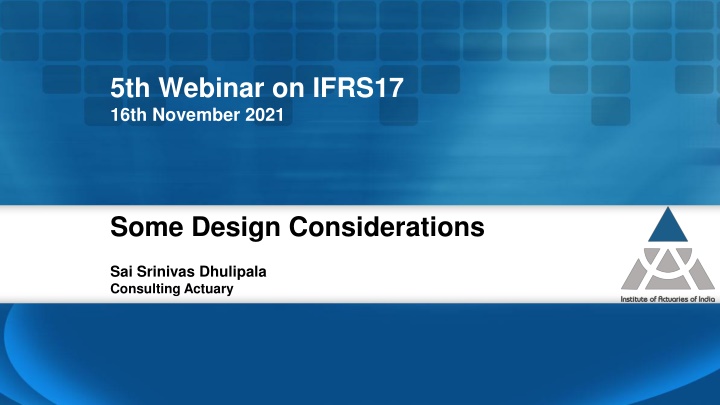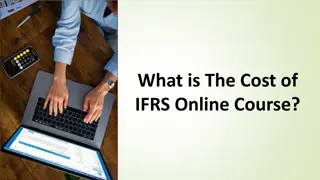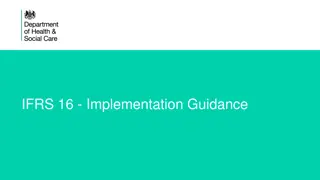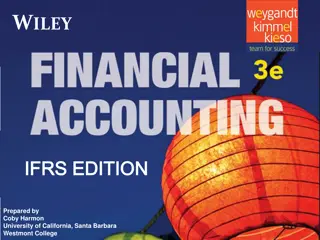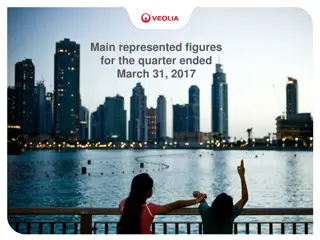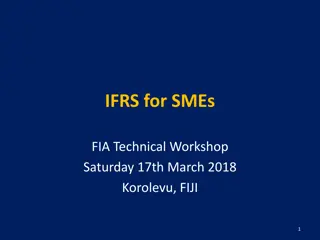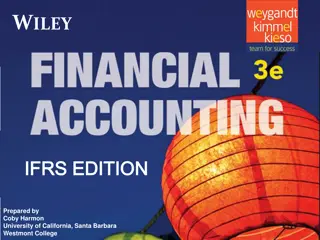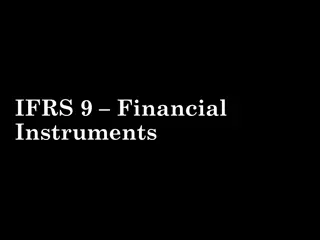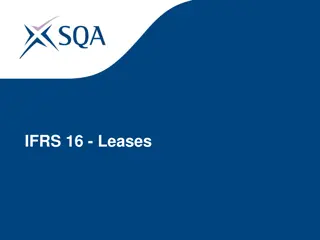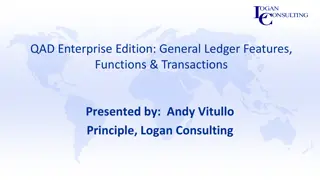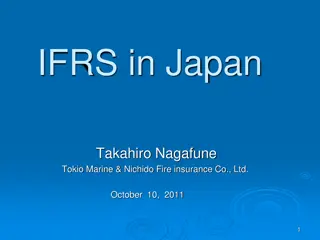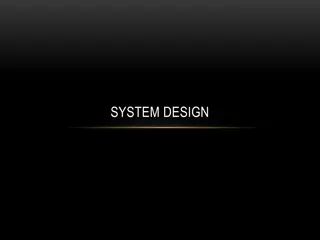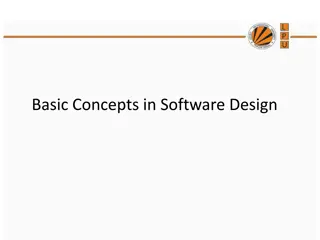IFRS 17 Implementation: Key Design Considerations
Implementation of IFRS 17 requires a structured approach in the design phase to avoid disruptions to business operations and financial systems. This article emphasizes the importance of proper planning, assessment, and execution to ensure a smooth transition. Key topics include level of aggregation, group of contracts, portfolio management, and profitability measurement models.
Download Presentation

Please find below an Image/Link to download the presentation.
The content on the website is provided AS IS for your information and personal use only. It may not be sold, licensed, or shared on other websites without obtaining consent from the author.If you encounter any issues during the download, it is possible that the publisher has removed the file from their server.
You are allowed to download the files provided on this website for personal or commercial use, subject to the condition that they are used lawfully. All files are the property of their respective owners.
The content on the website is provided AS IS for your information and personal use only. It may not be sold, licensed, or shared on other websites without obtaining consent from the author.
E N D
Presentation Transcript
5th Webinar on IFRS17 16th November 2021 Some Design Considerations Sai Srinivas Dhulipala Consulting Actuary
Introduction 20% Plan & Assessment 30% Designing IFRS 17 Implementation work flow 30% Execution 10% Testing Roll-out 10% www.actuariesindia.org
Introduction Implementation of IFRS 17 brings significant changes to entity s systems, processes and data management It may impact business operations and financial systems of the entities unless it is carefully planned in structured way in designing phase itself A lack of understanding and coherent approach in design stage may further derail the implementation plan and may consume more money, time and resources www.actuariesindia.org
Level of Aggregation Group of Contracts basic unit of account for CSM accounting Portfolio Cohort Profitability Measurement model www.actuariesindia.org
Group of Contracts Portfolio Cohort Profitability Measurement model www.actuariesindia.org
Portfolio Portfolio component of entity at which the statement of financial position is expected to be provided Interpretation of similar Risks and managed together Contracts in different product lines would not be expected to have similar risks LOBs are natural portfolios Decision on managed together www.actuariesindia.org
Portfolio Portfolio Guidance by IFRS 8 Whose operating results are reviewed to make decisions about the resources to allocate and assess its performance May need further factors to assess performances Distribution channel or major partner, or a product line www.actuariesindia.org
Group of Contracts Portfolio Cohort Profitability Measurement model www.actuariesindia.org
Cohort Annual vs Quarterly Quarterly performance can be tracked (group biz) Need to weigh this against too many groups and the associated complexity www.actuariesindia.org
Group of Contracts Portfolio Cohort Profitability Measurement model www.actuariesindia.org
Profitability Testing of Onerousness Where do you test the onerousness? Actuarial software IFRS17 solution system ETL Other means What other means are possible? www.actuariesindia.org
Profitability Prior tagging of profitability is required Cash flows and Risk adjustment tagged at GOC is used for CSM Unless tagged, separate GOC can t be created for onerous contracts Can be based on reasonable and supportable information A few choices can be followed VNB / VNB at risk CSM at risk for range of policies covering portfolio Create a rule engine to decide the tagging for every contract www.actuariesindia.org
Group of Contracts Portfolio Cohort Profitability Measurement model www.actuariesindia.org
Measurement Model Default model is GMM VFA eligibility testing Testing required to be done at contract level. But may accept one assessment for homogeneous contracts in same market conditions and priced on same basis First condition is to be fulfilled at fund level, but other two conditions need to be tested at lower level. A set of KPIs need to be defined at inception Is profit sharing based on investment returns Is profit sharing including minimum guarantee deemed substantial? Are the fixed cash flows significant? Is the financial guarantees embedded out-of-money deemed substantial? www.actuariesindia.org
Measurement Model - VFA Substantial Need to be defined with formula specified with a range to decide the eligibility. For example: Yes if >55%, no if <50% and need further analysis otherwise Further analysis may involve several scenarios or stochastic simulations to assess the average or variability in the sharing Contracts within a product ideally shall be eligible/not eligible Eligibility is expected to be consistent year-on-year www.actuariesindia.org
Measurement Model - MGMM If VFA test is not passed indirect participation Indirect Participation Modified GMM The cashflow model needs to incorporate the basis for determination of benefit at inception The process for capturing the adjustment to CSM should be clearly outlined in the model Mutualization System to accommodate the mutualization adjustments to FCF & CSM on subsequent measurement at higher level than GOC and then allocate back to GOCs www.actuariesindia.org
Measurement Model - PAA PAA Eligibility test required for contracts with more than one year term Contracts of life insurers can be easily modelled using GMM Testing may be useful for Non-life contracts Clear KPI s on base LR and sensitivity to assess the eligibility Sensitivity on discount rates also required to judge the variability Products eligible for PAA expected to demonstrate consistently year-on-year Reinsurance Annual treaties are expected to be eligible for PAA www.actuariesindia.org
Group of Contracts Once you establish Group of Contracts, you need to align the other cash flows to arrive at desired financial results either at group level or further down Sub Groups Risk Adjustment Reinsurance Allocation of expenses www.actuariesindia.org
Group of Contracts Sub Groups Risk Adjustment Reinsurance Allocation of expenses www.actuariesindia.org
Sub groups GOC may contain more than one product sharing similar risks Require sub-groups (Actuarial group) with each product as group for the actuarial reasons Cash flows & Assumptions In addition to actuarial cash flows, other business transaction such as Incurred claims including NDIC, actual premiums & allocation of expenses to compare the actual vs expected would be more reasonable at these Actuarial groups Clear mapping with these actuarial groupings to GOC in order to account the changes to CSM / OCI at GOC level www.actuariesindia.org
Group of Contracts Sub Groups Risk Adjustment Reinsurance Allocation of expenses www.actuariesindia.org
Grouping Risk Adjustment Risk adjustment (RA) shall be calculated at GOC to account for CSM However, Risk adjustment require stress testing of cash flows for each risk and allow for diversification Stress testing / diversification would normally done at entity level Need process / system to allocate the risk adjustments to the actuarial groups and to aggregate at GOC level Seamless process to allocate the impact of variances / change in assumptions on Risk adjustment to actuarial groups and GOC to account for subsequent measurements www.actuariesindia.org
Group of Contracts Sub Groups Risk Adjustment Reinsurance Allocation of expenses www.actuariesindia.org
Grouping Reinsurance Discussion about reinsurance held Level of aggregation in addition to LOB, the additional factors would normally be type of coverage (proportional v/s non-proportional, loss occurring v/s risk attaching) Grouping portfolio, net gain/loss, measurement model, cohort For cash flow purposes actuarial groups lower than GOC Contract boundaries & measurement models are different with underlying Loss recovery - One-to-one mapping is not possible with underlying actuarial groups / GOC. Need a process / system to establish the relationship for loss recovery with corresponding underlying GOC www.actuariesindia.org
Group of Contracts Sub Groups Risk Adjustment Reinsurance Allocation of expenses www.actuariesindia.org
Allocation of expenses - GOC Identification of directly Attributable expenses by nature of expense / head of expenses Set process to identify directly attributable expenses Acquisition, policy service and claims related Start with expenses identifiable at policy or GOC Process to identify the overheads which are directly attributable Acquisition, policy service and claims related Decide on and separate the pre-coverage acquisition Other directly attributable into acquisition / maintenance Establish ETL process to allocate the expense directly attributable acquisition (non pre-coverage), directly attributable maintenance expenses and general expenses www.actuariesindia.org
Conclusion Design is very critical Requires lot of clarity and understanding Its not purely technical decision Its also influenced by the way the business is driven Some of the decisions may be irreversible Or very expensive to reverse Hence its important to be as perfect as possible with your design www.actuariesindia.org
Questions www.actuariesindia.org
